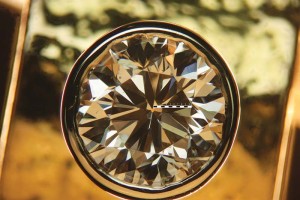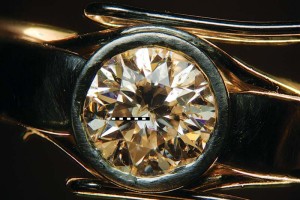A little math, anyone?

The formulae we rely on for weight calculations are based on volume and specific gravity. For some gems, such as diamond, the specific gravity is relatively consistent, although the style of cutting and variations in proportion details can significantly influence the stone’s volume. For a standard round brilliant diamond, the general formula for calculating weight is usually given as: (average diameter in mm)² X (total depth in mm) X 0.0061. There are a few assumptions built into that formula requiring us to make adjustments for any specific diamond.
For instance, depending on the stone’s size, one with a slightly thick girdle may require a one to five per cent adjustment, a thick girdle may necessitate three to six per cent, and a very thick to extremely thick girdle may need as much as a five to 12 per cent addition to the calculation. Smaller stones will require the larger adjustment percentages. With experience and practice, sight estimation of girdle thickness can yield credible results, but direct measurement of the girdle is usually more accurate. In addition to girdle thickness, deviations in crown angle, crown height, culet size, and shape irregularities may potentially require weight adjustments.

Sometimes sight estimation techniques are necessary to have the data required to calculate the weight. A large percentage of the diamonds I examine are mounted in closed-back settings that preclude the possibility of direct measurement of the total depth. Unless the prongs extend above the height of the stone, I can normally place the base of my digital micrometer flat on the diamond’s table and extend its rod to the lowest point of the girdle. I make note of this measurement (crown height + girdle thickness) and proceed to sight estimation of the pavilion depth percentage. Many of us will recall that technique from our gemmology courses, but here’s a quick refresher. With our microscope at 10 to 15X zoom, we look through the diamond’s table at the pavilion for the reflection of the junction of the star facets and the table. Sometimes moving the needle’s tip across that junction makes the ‘bowtie’s’ reflection easier to spot on the opposite side of the pavilion.
Centring the culet in the table, we estimate the distance from the culet to the bowtie in relation to the table’s corner. If the bowtie reflection is one-quarter the distance to the corner of the table, the pavilion depth percentage (PDP) is approximately 41 per cent. If it is one-third, then 43 per cent PDP; half is 44.5 per cent, two-thirds is 45.5 per cent; and three-quarters is 47 per cent. And if the reflection is at the edge of the table, the PDP is approximately 48 per cent. Interpolation is often necessary to achieve greater accuracy.
Once we have estimated the pavilion depth percentage, we can convert it into a millimetre measurement by multiplying it by the average diameter. Finally, we add that dimension to the crown height + girdle thickness measurement previously recorded to arrive at the approximate total depth dimension we need to apply the formula. With practice, it is possible to achieve a margin of error of less than three per cent for the weight calculation. I often rehearse this technique using mounted diamonds with open-backed settings and those with a grading report from a lab I trust. Unfortunately, this method is only applicable to round brilliant diamonds; fancy shapes require a different approach.





